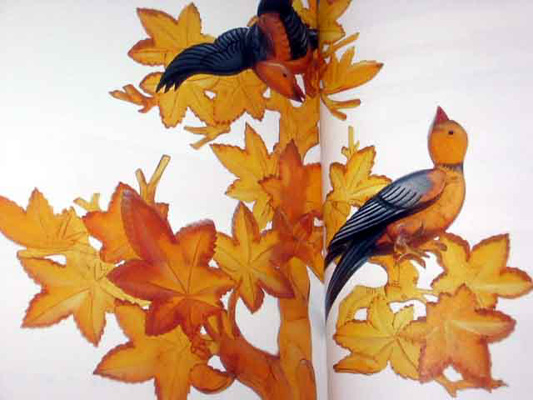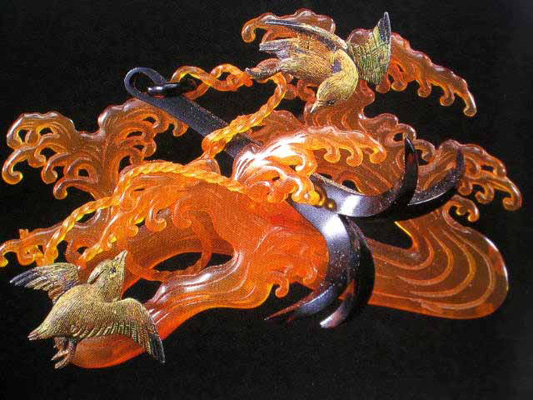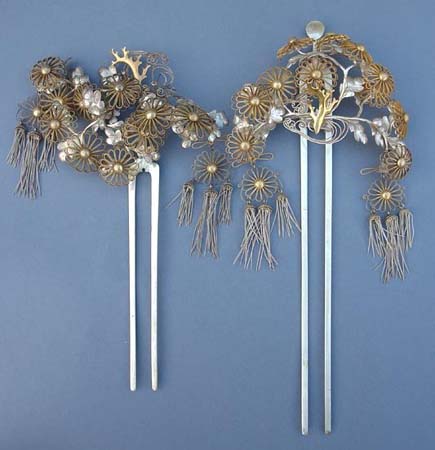There have been some beautiful things sold on ebay recently.
A beautiful tortoiseshell, gold makie, and coral kogai stick from the Edo period sold for $490 on Nov. 28. You may refer to Auction #300174753664.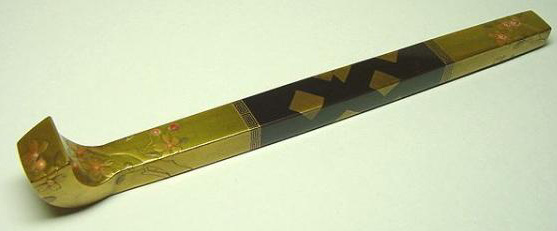
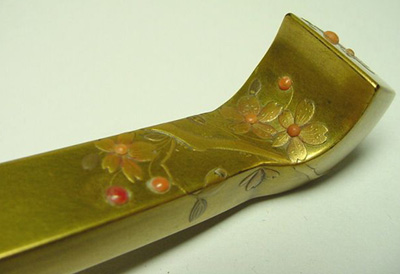
A Showa tortoiseshell kushi with two layers of leaves flowing in the wind sold for $257.82 on Nov. 25. You may refer to Auction #330189054886.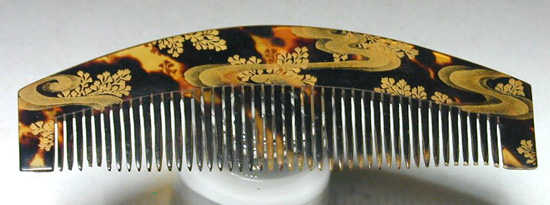
A gorgeously carved Victorian ivory comb went for the stunningly low price of $86 because two pieces of it were missing. When such a beauty, with no discoloration, has damage, I hold my head in my hands. Anyway, it was a great bargain, and a beautiful comb. You may refer to Auction #230197013812.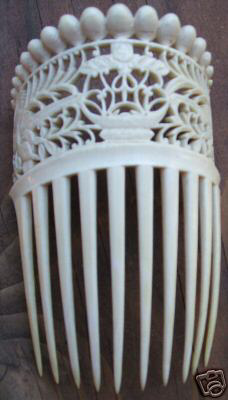
A beautiful 14K rose gold hair pin sold for $383 on Dec 6. You may refer to Auction #250193680625.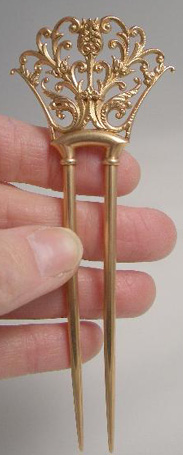
On Dec 10, this matching set of beautiful garnet butterfly hairpins went for $760. You may refer to Auction #170174938274.

This beautiful late Edo tortoiseshell kanzashi, c. 1850, sold for an excellent price of $152.53 on Dec 9. The pins are smaller because it was made to be worn at the front of the geisha’s wig. The quality of the shell is translucent blonde and extraordinary. You may refer to Auction #110201844429.
And finally, I bought this butterfly ivory comb on Ruby Lane recently for $245. It looks pretty discolored, but no pieces are missing, and I loved it, so c’est la. Update: I received it. It’s not discolored at all, and it’s huge. I’m thrilled with it.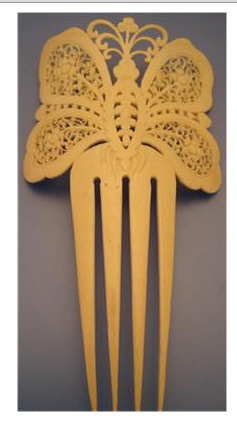
Category Archives: English Hair Comb
Kind Hearts and Coronets
This peeress coronet was made for a countess, the wife of an Earl, to be worn at the coronation of Edward VIII. It was made in London, 1936, for the coronation , which was planned on the 12th of May, 1937. However, Edward abdicated in December 1937 to marry divorcee Wallis Simpson, and the coronation never took place.
The coronet would presumably have been worn at the coronation of his brother George VI later in 1937. It is made of a circlet of silver, gilded, with eight strawberry leaves and eight balls on raised points denoting the rank of Earl. It is lined in crimson silk velvet with gold tassel and trimmed with ermine around the base. It was designed to be worn on the top of the head, usually in conjunction with a tiara, so is 16 cm [6.25 inches] in diameter and 16 cm [ 6 .25 inches] tall.
This text and image must be credited to Rowan and Rowan, a shop in London that has fabulous things, most notably cameos. I have bought two things from them, but I missed this by minutes! Argh!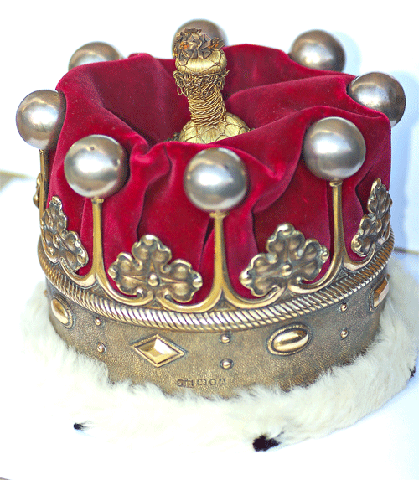
What A Difference A Century Makes
Sothebys is having an auction of magnificent jewels, and as I was looking over the tiaras, I couldn’t help but be struck by the contrast between one made in 1870 and another made in 1970.
The Victorian tiara is made of open work panels of stylised Greek key and foliate scrolls, whereas the 70’s piece is a hinged crescent of elongated panels. What a difference a century makes. However, I have to admit, I totally see a Star Wars Princess in that 1970’s tiara. ;-)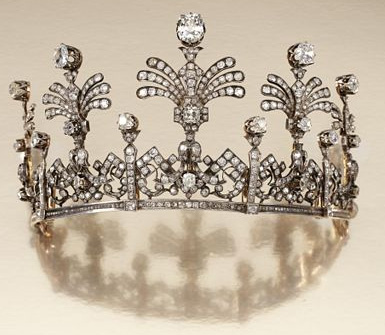

Some Lovely Things on Ebay and Beyond
This delicately carved blond tortoiseshell comb with 18-karat gold pique, c.1890, sold for $258.88 on Nov. 11. You may refer to Auction #220168340896.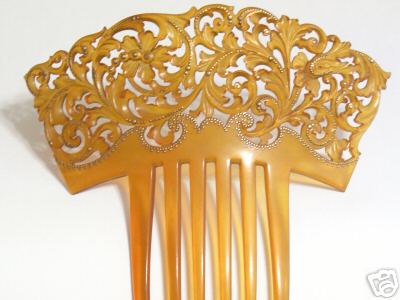
This beautiful blond tortoiseshell hairpin with 14-karat gold decoration and a bar of sapphire and diamonds attached, sold for $229.38 on Nov. 11. You may refer to Auction #220168352193. I thought this one was ridiculously underpriced. I wonder where everyone was.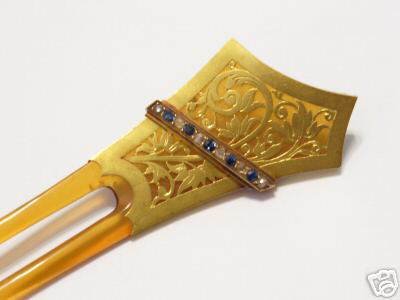
This Meiji gold, silver, and coral bira bira kanzashi went for $305 on Oct. 22. You may refer to Auction #300161851114.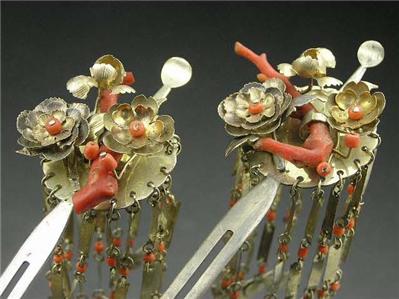
I’m buying this Japanese silver, gold plate, and black enamel Showa set from Shigeru’s brother in Japan. I liked the 3-dimensional quality of it. Lotus flowers in a pool of water.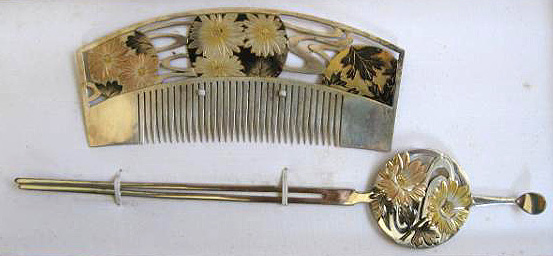
I’m also in installment payments to buy this, a total Barbara piece. It’s Regency, c.1820, a floral spray with rhinestones. One of those flamboyant things I had to have, or I’d die. But it seems I’m that way with everything I love. When the Prince Regent, George, stepped in after his father George III went mad in 1811and then ruled from 1820 – 1830, England named the fashion period, Regency, after him. 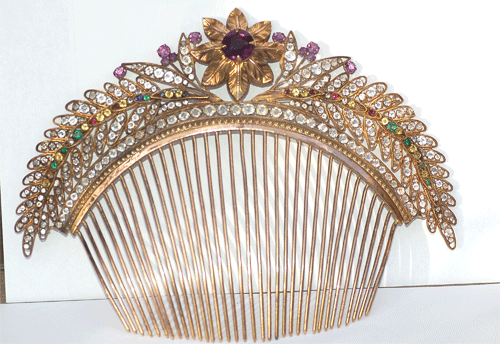
Tiara Leaves
During the Victorian period, archeological discoveries in Rome and Greece captivated the imagination of jewelers. Leaves found on ancient headpieces became a favorite ornament in tiaras. Here are four lovely examples.
This French tiara, c. 1820, is set in a patterned, gilded frame with faceted crystals. It depicts a spray of hyacinth leaves with raised flower buds. It sold last year for 1000 GBP from a dealer in London.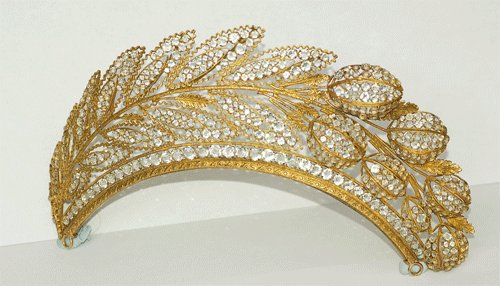
This English gilt metal tiara and brooch has flowering sprays of myrtle. On the blue velvet cushion that came with it, silver thread was embroidered to read “d.11ten Januar. 1867.” It sold at Sothebys in London for 4,320 GBP.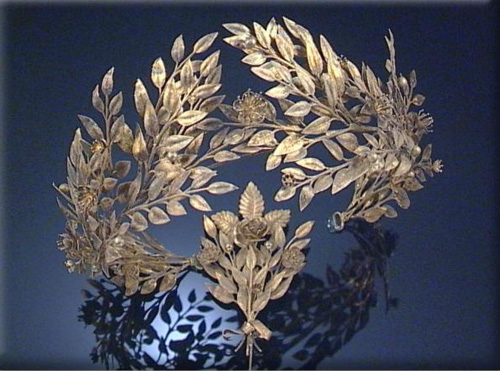
This Castellani Archeological Revival Gold tiara, c. 1870, is a simple gold branch bearing sprigs of olive leaves, with circular openings at either end for ribbons. It was exhibited at The Bard Graduate Center in New York, Somerset House in London, and Villa Giulia in Rome, and sold for $19,200 at Sothebys.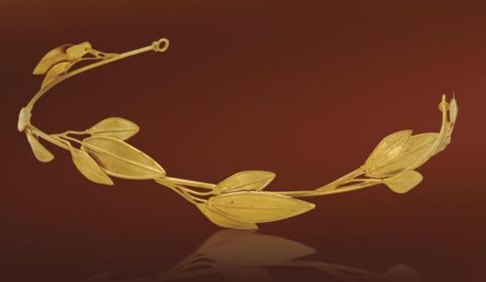
Last is this diamond tiara, designed as a spray of fern leaves set with cushion-shaped and rose diamonds. The fitted case is by J & P Bapst & Fils Joalliers, 25 Rue du Faubs St Honore, Paris, c. 1870. Sale Price: 82,700 GBP at Sothebys.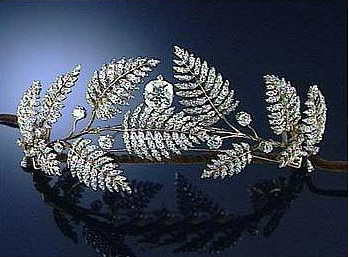
Flamboyance
I’m in the mood for the unusual today, so I thought I’d showcase a few combs that are flamboyant variations of the ones we usually see.
These silver and gold kanzashi from the Meiji era are over-the-top attachments to silver pins. They have 16-petal chrysanthemums, leaves, gold branches, and fringe. They were sold on Trocadero for a ridiculous price because I know this dealer. ;-) I didn’t buy them, though. :-(
This tortoiseshell comb boasts 3 carved shell cameos, one of Athena and two of Flora. It sold for $1295 on Ruby Lane, even with two slightly broken tines and a seperation in the scrolled ornamentation at the top. The dealer thought it was French, 1860. I am not sure. With the craze surrounding archeological discoveries that took over Victorian England, it might be English. I’m undecided, but I love it.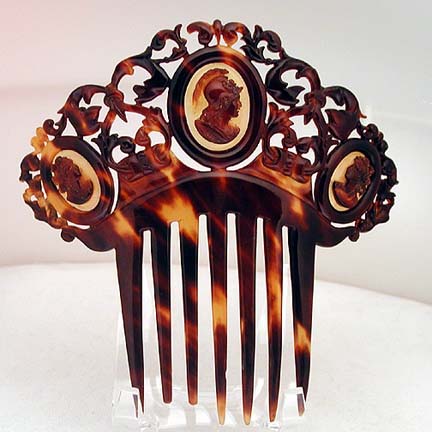
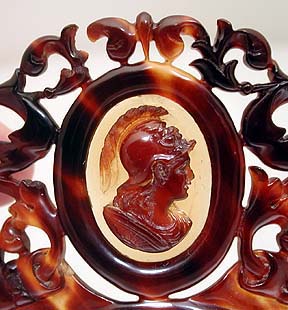
This one I am buying. It’s a Victorian Algerian, c. 1870. As aluminum was discovered in 1827, when this was made, the metal was more valuable than gold. Alas, today, the materials in this comb are worth about 35 cents, but I had never seen one like it, and I had to have it. :-) The leaves are acanthus leaves, after Cesar’s headpiece. The chains are silver, and the beads are turquoise-colored glass. I guess one wore this with a toga-like white gown.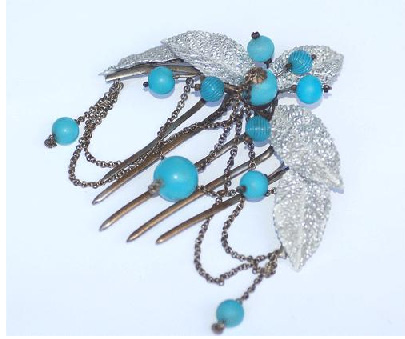
This Edo tortoiseshell comb with a silver- and gold-plated copper frame, decorated with coral beads, sold on ebay for $1000 on Oct 15.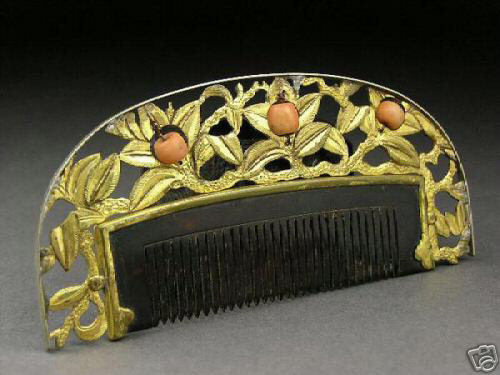
I thought this celluloid comb had humor and originality. It is English, c. 1890, and sold on ebay as part of a 7-piece lot.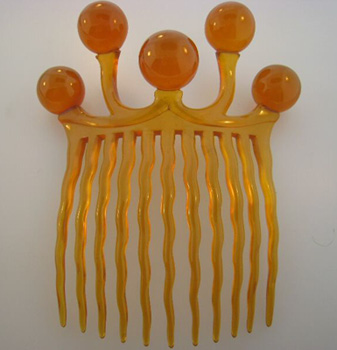
And last, becuase I must, a flamboyant 19th-century tiara of 18K gold with diamonds, emeralds, rubies, amethysts, garnets, and topaz. I loved all the colors. :-) It is available for sale at a jewelry store on Madison Ave. in Manhattan, which was featured in a NOVA special on diamonds, as having one piece of the French crown jewels.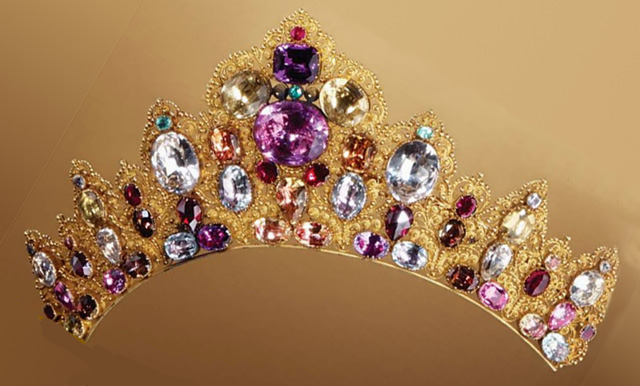
Some Lovely Things on Ebay
There have been some lovely things on ebay recently.
A wonderful 14K gold griffin on a silver base, attached to a tortoiseshell comb sold for $550 on Sept. 27. It has a diamond in its mouth, diamonds on the wings, and a ruby cabachon eye. You may refer to Item #170151496226.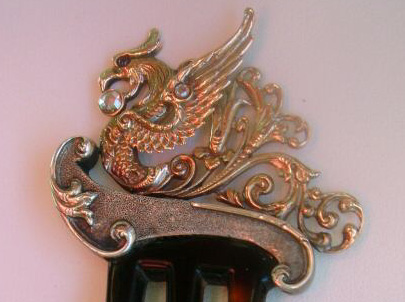
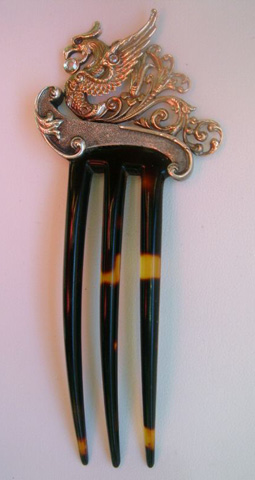
A beautiful Meiji silver-and-gold kanzashi set depicting a bowl, vase, and spoon sold for $465 on Sept. 26. Only one is pictured here so you can see the closeup. You may refer to Item #300153292268.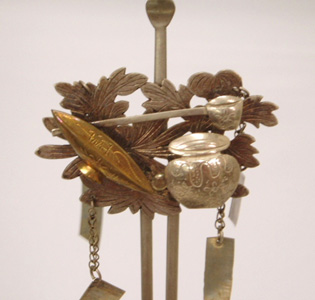
This Victorian garnet tiara hinged on a tortoiseshell comb just sold for $308 on Sept 24. Excellent price for such a lovely star-laden tiara design.You may refer to item #170150463040.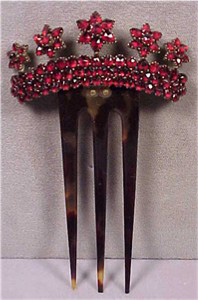
This beautiful Edo kogai stick sold for $660 on Sept 17. It is made of tortoiseshell and decorated with apricot flowers. If you look at the closeup, you can see that little bell flower with the pistels. These painted flowers have the same design as the carved flowers on both shell kanzashi, and the bakelite kanzashi from those Japanese wedding sets they made in the 1940s. You may refer to item #110168679851.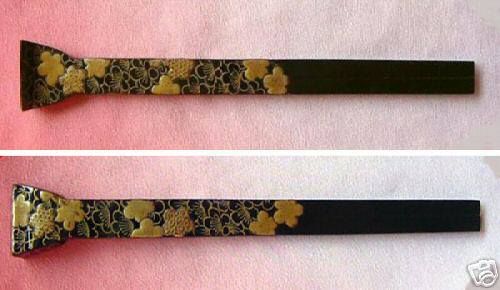
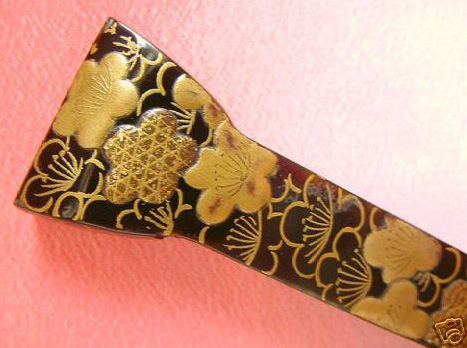
This ivory Edo kogai stick with gold maki-e paint and inlaid jade and coral sold for $300 on Sept. 17. You may refer to Item #330164680560.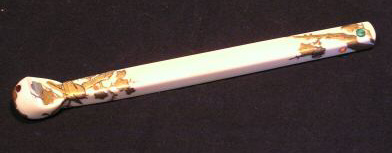
This lovely carved shell floral design on a Meiji set went for $152 on August 30. The stick in between the kogai pieces is wood. There are bug bites on the shell kushi, and that brings the price down considerably. In perfect condition, this would have gone much higher, but I thought $152 was an excellent price for this.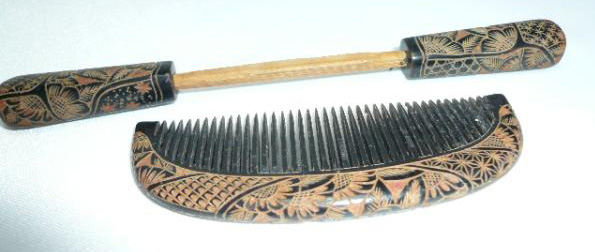
This is a gorgeous piece. The Meiji tortoiseshell kushi depicts waves and is inlaid with pearl. Excellent Condition. It sold for $646 on Sept 22. You may refer to Item #300151918225.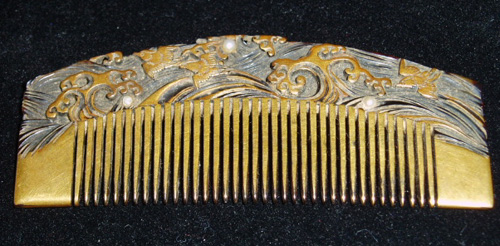
And finally, for today :-), this beautiful Victorian ivory comb sold for $355 (I lost, sadly) on Sept 21. You may refer to Item #290161590846.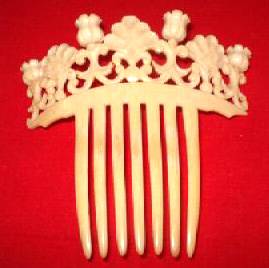
Some English Diamonds
Although conservative and tiara-like in design, diamond and shell Victorian and Edwardian combs are still breathtaking. I love them. Here are three that sold at Sotheby’s last year.
Pearl and Diamond hair comb; c. 1890; sold 13,200 GBP; 29, June, 2006; London.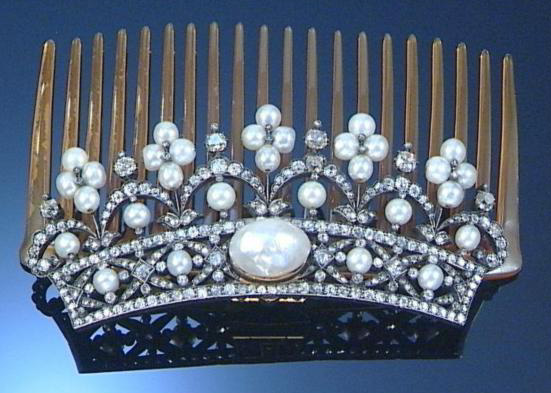
Diamond and blonde shell comb; c. 1910; sold 15,600 GBP; 15, December, 2006; London.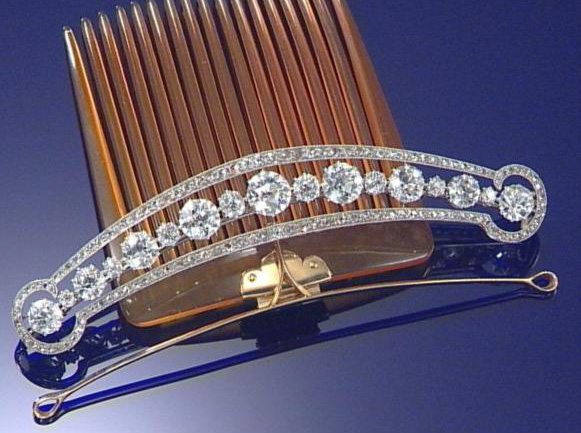
A golden eagle and serpent engaged in combat top this dark tortoiseshell comb, c. 1850. It is decorated with green and white enamel, and ruby and pearl highlights. Sold 3000 GBP; 29, June 2006; London.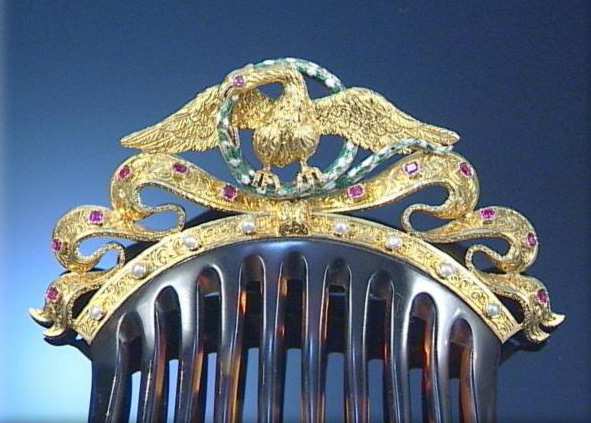
Coral Cameo Comb
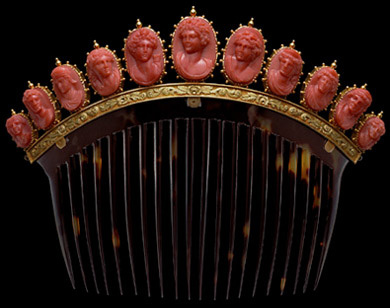
This tortoiseshell comb showcases 11 coral cameos in gold-beaded mounts, which rest on a gold base decorated with acanthus leaves, First half of the 19th Century.
Each cameo represents a divinity, or Bacchante, a priestess of the Greek God Bacchus. Bacchante cameos were popular with engravers in late-18th-Century Rome, who carved them in hardstone and shell. European travellers to Italy fell in love with them.
One hundred years later, Empress Josephine’s love of coral combined with the material’s ability to be cut into cameos might have inspired jewelers to make this design, a 19th-Century interpretation of the earlier Italian trend.
Empress Josephine loved coral’s noble rich-red color, wearing it herself and giving coral jewelry as presents. She did much to make coral fashionable in France, reflecting the French passion for classical art. Indeed, coral jewelry was considered most effective when worn with dresses of white muslin, copying the look of a Greek statue.
Some Lovely Things on Ebay
There have been some lovely silver and coral kanzashi selling for excellent prices on ebay. Very unique objects, such as a man-with-hat and an instrument, were attached to the hairpins. The Meiji man-with-hat went unsold at $350, whereas the Edo kanzashi of a Japanese traditional instrument with fish carved into the hairpin itself sold for $390. The shell bird kanzashi with gold makie went for $293. 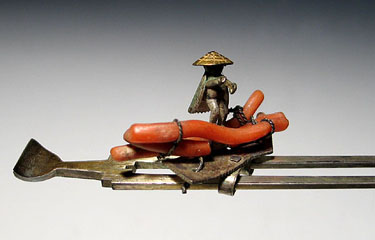
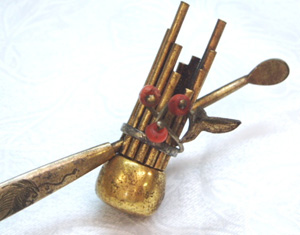
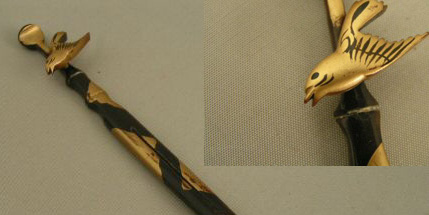
Two elaborately carved Meiji tortoiseshell kushis also sold, but at very different prices. The first one had a complex design of fans and flowers, no bug bites, and was signed. The second one had an elaborate floral design of chrysanthemums and peonies, a few bug bites, and was not signed. There was a significant price differential. Kushi #1: $577 on July 14; Kushi #2: $127.50 on July 15.
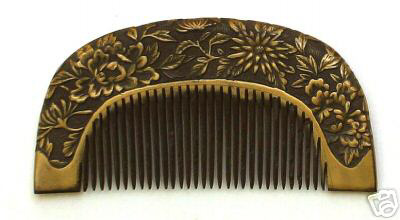
There was also a lovely brass Victorian tiara, which went unsold at a starting bid of $275.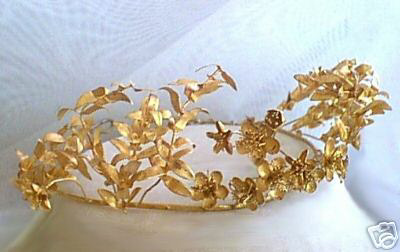
A beautifully balanced design marks this lacquer over shell signed Meiji set, which sold for $283.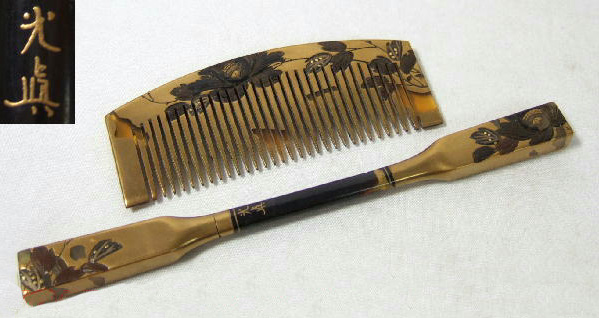
And I will end this post with two more museum-quality blond tortoiseshell kanzashi ornaments of plover birds flying over the sea.